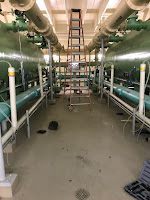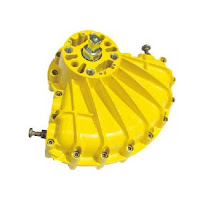Water hammer, or hydraulic shock, is a significant challenge in municipal water treatment systems. This phenomenon occurs when a sudden change in water flow velocity—often due to rapid valve closure—creates a pressure surge or shock wave within the pipeline. Depending on pipe material and water temperature, these surges can travel at speeds up to 1,400 meters per second, potentially causing severe damage to infrastructure, disrupting water supply, and compromising water quality.
Fast-closing valves are the primary instigators of water hammer events. An abrupt valve closure instantaneously halts the momentum of flowing water, leading to a pressure spike that can exceed the pipeline's design limits. This can result in burst pipes, damaged fittings, and failed valves, necessitating costly repairs and posing risks to public safety.
Rotary hydraulic dampers, commonly referred to as dashpots, are silicone filled, vacuum sealed devices, expertly designed to regulate the velocity and smoothness of rotational movements.
Kinetrol's Steadyline actuators offer an innovative solution by combining a standard Kinetrol rotary actuator with an attached rotary dashpot to govern the valve's closing speed. This design leverages the reliability and performance of Kinetrol's established rotary actuators while integrating a specialized dashpot mechanism that precisely controls the actuator's rotational movement during valve closure.
The Steadyline actuator's configuration involves mounting a rotary dashpot directly onto the standard actuator's output shaft. The dashpot consists of a rotor moving within a fluid-filled chamber, where the viscous fluid resists the rotor's motion. As the valve begins to close, the dashpot slows down the rotational speed by absorbing kinetic energy through fluid friction. This controlled resistance ensures the valve closes smoothly over a predetermined period, significantly reducing the risk of inducing water hammer.
Beyond preventing physical damage to the pipeline network, the controlled valve closure provided by Steadyline actuators improves operational efficiency. By mitigating water hammer, the actuators reduce stress on pipes and fittings, extending the lifespan of the entire distribution system.
Implementing Kinetrol's Steadyline actuators can lead to substantial financial savings for municipal water utilities. By preventing infrastructure damage and reducing the frequency of repairs, utilities can allocate resources more effectively and avoid unexpected expenses.
Kinetrol's Steadyline actuators provide a valuable and practical solution to the challenges water hammers pose in municipal water treatment systems. By integrating a standard rotary actuator with an attached rotary dashpot, these actuators offer precise control over valve closing speeds without compromising reliability or ease of installation. This design not only safeguards the physical infrastructure and ensures efficient water supply system operation but also contributes to maintaining water quality and delivering financial benefits through reduced maintenance costs. For municipalities seeking to enhance the safety and sustainability of their water distribution networks, adopting Steadyline actuators represents a strategic investment in advanced engineering solutions.
https://kinetrolusa.com
972-447-9443













